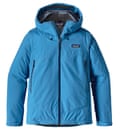It was probably the only time a 93-year-old has stolen the show at Glastonbury’s Pyramid stage. Sir David Attenborough had important things to say when he warmed up for Kylie Minogue last month. After showing scenes from Blue Planet 2, the wildlife series credited with inspiring a sea change in attitudes towards plastics pollution, the broadcaster thanked festival goers and organisers for banning single-use water bottles. “This great festival has gone plastic-free,” he said to cheers. “Thank you! Thank you!”
Kylie’s crowd was right to feel virtuous – single-use plastic is an oil-derived menace to marine life – but how many paused to look down at the elastic in their waistbands, the polyester in their T-shirts and the nylon in their shoes? Plastic in what we wear may be less visible than it is in bottles or straws, but it is no less toxic. Yet somehow we have woven it so tightly into our throwaway society that we barely notice it, even when it is on our own backs. Now there are moves – at the top and bottom of a complex global supply chain – to do something about it.
“When I started doing this five years ago, suppliers wouldn’t even show me their recycled fabrics or they wouldn’t even have them in their bag,” says Kimberley Smith, head of production at a US clothing company Everlane. Since her company committed to eradicating all non-recycled, or virgin, plastic from its supply chain, stores and offices by 2021, her job has become a mission to demand more of them. “Now, recycled is the first thing they show us,” she adds.
But that mission is also about fighting apathy and ignorance among shoppers. “There’s a lot more pressure now to be more educated about issues like water and air pollution, but I think people aren’t as clear that, ‘Oh, by the way, your know your fleece or your Puffa jacket is made of virgin oil?’ I don’t think people understand,” says Smith, who has previously worked at Gap and Levi’s.

Perhaps the development of synthetic fibres as a way to mimic natural fabrics – and add clever functionality – helped obscure the plastic in so much of what we now wear. You don’t have to check a label on a bottle of water, for instance, to know what it’s made of. With textiles, change started slowly. First came plant-derived synthetic fibres such as rayon, which used wood pulp. Truly synthetic fibres arrived with nylons in the late 1930s (courtesy of DuPont, the American chemicals giant that also developed rayon), while polyester was a 1940s British invention.
A process called polymerisation had given us plastics with innumerable potential uses, from hosepipes to dental floss. Melted down, plastic chips could be spun into a strong, light, fast-drying plastic yarn. When it was launched in stockings in a storm of publicity, nylon was more expensive than silk. New technology carried a premium. War swiftly diverted production to parachutes and tents, and synthetic stockings, or “nylons”, became a currency on the black markets of Europe, but mass production geared up thereafter and synthetic fibres wove their way across the world.
Plastic goods of all kinds were celebrated for their utility and diminishing cost – but also their very disposability. In a 1955 edition of Life magazine, a family was photographed throwing dozens of everyday household goods into the air, including some made of plastic. “Throwaway Living” was the headline. The objects in the picture “would take 40 hours to clean – except that no housewife need bother”, the magazine said. “They are all meant to be thrown away after use.”

Throwaway culture might not be as celebrated today, but the same globalising forces on commerce and trade means it has spread into clothing. How often do you wear a T-shirt bought for £4? And what do you do with yours once it has lost its shape or fallen apart (if it hasn’t already disappeared at the bottom of a drawer of similarly priced clothing)? A return to using more cotton would alleviate the plastics problem, but no fast fashion is truly green; it can take up to 22,500 litres of water to grow a kilo of cotton in parts of India that are already water-deprived. Moreover, there are things that cotton can’t do, such as keep the rain out or repel sweat.
Production of polyester alone has multiplied 10 times since 1980, to 53.7 million tonnes in 2017, according to data collated by the Textile Exchange, a US nonprofit industry body. Polyester now accounts for 51% of all fibre production, twice that of cotton (synthetic fibre production overtook cotton in the mid-1990s). That’s a lot of oil, energy and air miles. Yet we throw away an estimated 48 million tonnes of clothing of all types each year, 75% of which ends up in landfill or is incinerated. Less than 1% of clothing was recycled into new clothing in 2017.
And plastic clothing can be uniquely toxic, even while it is still in use or after it has been recycled. A 2016 study by the University of California at Santa Barbara found that, on average, polyester fleece jackets release 1.7 grams of plastic microfibres each time they go into the wash. Older jackets shed more and almost half the barely visible fibres made it through water-treatment plants into rivers and seas. Microbeads of the sort used in cosmetics were banned in the UK last year, but microfibres may be just as destructive – and prevalent. A Plymouth University study estimated in 2016 that a single six-kilo load of synthetic laundry could release 700,000 tiny bits of fibre. Their toxic effects have been observed concentrating as they pass up the food chain, devastating marine life and, in an unappetising case of unwanted recycling, ending up on our dinner plates.
The basic technology needed to dress a growing global population more sustainably has existed for decades. “We launched our first recycled polyester fleece in 1993,” says Matt Dwyer, director of materials innovation at the US-based outdoor-clothing giant Patagonia. The fleece now lives in the company’s archives and is still a faded pale green – it was made of discarded plastic bottles before green and clear bottles were separated. “I’ve handled it and it’s a bit crispy now and the quality wasn’t quite there, but that’s not the story now,” Dwyer adds. More than 80% of the synthetic material Patagonia uses is now recycled and that proportion should hit 90% in the next year.
By sorting and processing old plastic into shreds and then turning them into chips, recycled-fibre producers such as the US-based Unifi, which makes Repreve, a recycled fibre, can spin the chips back into yarn. Unifi alone has processed more than 16bn bottles since 2008, and hopes to hit 30bn by 2022. The company supplies Patagonia as well as brands including Ford, for which it makes seat coverings.
Dwyer says myths that remain about recycled materials often become excuses. There is an assumption that there isn’t enough of it (“There’s plenty of waste that needs picking up,” he says), that it’s still low-quality and that – crucially, in an industry of tight margins – it’s too expensive. “Any business of reasonable size can buy enough recycled material to defer costs,” Dwyer adds. Perhaps more tellingly, there has not been a sense of demand from the bottom. “That’s the other big excuse: ‘My customer doesn’t care so why should I?’”
Patagonia is now an industry poster child for sustainable fashion and Dwyer receives regular calls from other companies starting from zero. They all ask the same question: “Where do we start?” Dwyer advises them first simply to ask suppliers where their stuff comes from. “The other thing I tell them is that making supply chains traceable and using recycled materials is future-proofing, because at some point your customer will care or – worse – it will get legislated and you’ll have to change anyway,” Dwyer says.

Companies are waking up to this future with varying degrees of commitment. Stella McCartney wants to phase out virgin nylon by 2020 and polyester by 2025. In the mass market, Adidas has committed to using recycled polyester in all viable applications by 2024. Meanwhile, brands such as Asos and Boohoo, which are synonymous with the excesses of fast fashion, have set out their stalls – or, at least, stalls within their stores. Asos has grown its Eco Edit since its launch in 2010. To qualify, clothing must contain at least 50% “sustainable” fibres, including recycled plastics. Last month, Boohoo launched For the Future, the brand’s first recycled range (“Dress well and do your bit for the planet? We’re totally here for it.”).
But is there not a risk of greenwashing when brands whose business models rely on cheap fashion position themselves as environmental crusaders? “You’ve got to make a big statement and put it out there,” says Smith at Everlane. “Saying, ‘We’re going to start a little baby eco line,’ is better than nothing but by setting a real target and telling everyone about it, you’re like: ‘OK, now we’ve really got to do it.’”
On Boohoo’s homepage at the time of writing, the link to the recycled range, which includes a T-shirt for £5.40, comes some distance below a “50% off absolutely everything” banner, a link to the summer and swimwear range with the slogan “catch flights not feelings” and right next to a link to non-recycled plastic swimsuits on sale for £5. There is nothing on Asos’s homepage to indicate it has an “eco” range (now called the Responsible Edit) – I have to click through to find it. Boohoo says its new range was more prominent on its site at launch and that it is only “the latest in a line of initiatives designed to make it easier for our customers to do the right thing”. Asos says it promotes its ethical range through several channels beyond its homepage and has added “responsible” filters to all its ranges rather than confining the clothes to one page.

Beyond recycled ranges, campaigners are asking whether fast fashion can ever be green. “The big issue I struggle with is that, yes, we can push for brands to become more sustainable, but as long as they’re churning out millions of garments a year, we’re not going to change anything,” says Tolmeia Gregory, a 19-year-old sustainable-fashion blogger and environmental activist. She has changed the way she dresses to include more secondhand clothes and sustainable brands, and is spending more on higher quality items that last longer.
Legislation may be part of the solution, but the government was accused of complacency last month after rejecting recommendations from MPs to improve fashion’s wider impact on the environment. In its report, Fixing Fashion, published in February, the Environmental Audit Committee said a 1p levy on each garment would raise £35m a year to improve infrastructure for the collection and sorting of clothes that otherwise go to landfill. It proposed a VAT cut on clothing repair and better rewards and penalties. The committee also recommended mandatory environmental targets for bigger retailers.
“There’s a spectrum of engagement in the industry, including those paying lip service to this new landscape, and we need regulation to set a level playing field,” says Mary Creagh, the chair of the committee. Creagh compares the forthcoming ban on plastic straws, stirrers and cotton buds with the government’s response to the report. “Straws was EU regulation but [the environment secretary] Michael Gove did a very good job of making it his own for a Brexiter,” she tells me. “The government likes to talk green but it’s not very good at walking the walk.” In its response, the government said it recognised the importance of tackling fast fashion and said it was already taking action, but it accepted none of the committee’s recommendations.

In the meantime, brands with an eye on the clock are making inroads. Those that rely less on synthetic materials are using new technology to recycle cotton, for example. On the Isle of Wight, Rapanui now offers customers £5 in credit if they return clothing to it for recycling rather than throw it away. Mart Drake-Knight, the co-founder of the company, says it has flourished because it has invested in sustainability. “We’re not hippies … we’re doubling in size each year – the economy has rewarded us for this.”
Sometimes it’s the little details that pose the biggest challenges for those trying to eliminate virgin plastic. Patagonia tried for years to find a supplier to make its logo labels with recycled plastic. At Everlane, plastic zips and buttons give Smith a headache. “The next big challenge is elastic,” she adds. “Everyone wants stretch now and that’s all made from virgin petroleum and there isn’t really recycled elastane out there yet.” She is hopeful a solution may yet show itself. Another effect of loudly self-imposing targets is that innovating suppliers hear the cry. “There are more and more people doing really cool things we didn’t even know about,” she adds. “The more people doing it and the more influence we have the better so we can make change together.”
